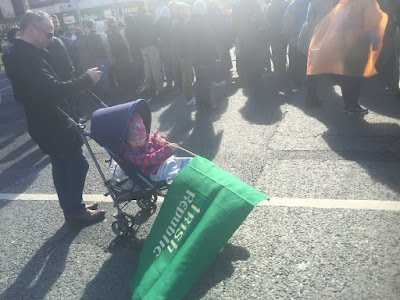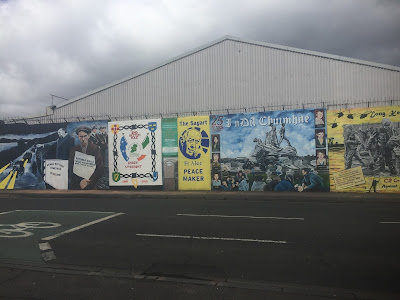Ladies and gentlemen, I dust off the old travel blog and give you: the first of a couple or three posts about Pierre and my recent trip to Ireland over the Easter holidays. There will be a lot of pictures, because Ireland is a beautiful and highly photogenic place, and hopefully some worthwhile text.
In advance of flying into Dublin a week ago today, I had carefully planned my route from the bus stop where I would be dropped to our AirBnB and back out to the General Post Office, where the ceremony marking the 100 year commemoration of
the Easter Rising would be taking place. But the best-laid plans of mice and men gang aft aglee, and mine agleed when a policeman boarded the 41 bus and announced last stop, as the center of Dublin was closed off for the Easter Rising parade.
Paddy, as I imagined the policeman to be named-- he sounded, by virtue of being Irish, like every cop in a film noir ever set in Chicago or New York, who are invariably named Paddy-- pointed me in the right direction. Before too long I started seeing roads lined with crowd-control barricades, which I followed to the main axe of the parade, O'Connell Street. Still unsure of exactly where things were in relation to each other, I decided to post up several hours in advance while the crowd was still sparse, rather than lugging my stuff around on a fruitless quest for the AirBnB.
With the advantage of ample time and a good viewpoint, I fell to chatting with a cluster of Dubliner women of a certain age, some accompanied by their young grandchildren. They had been children or young women when the 50-year commemoration took place, offset by a large protest from the Rev Ian Paisley and his hardline loyalists. The women traded fond memories of the parades of their youths, once an annual occurance, although subsequently suspended during the Troubles.
 |
| Start em young! Republicans from the cradle! |
The women only spoke passingly of this period, and I did not ask them to elaborate, but it came up nonverbally later on. As giant screens along the parade route projected the Irish prime minister, the Taoiseach, presiding over a preliminary ceremony at Dublin Castle, two photographers appeared on the parapet of a building behind us. While the women continued talking and joking ("I hear the Air Force will be doing a flyover." "Oh aye? All four of our planes?" "Come now, Ireland has at least seven!"), I noticed their eyes swing sharply to the figures outlined against the roof. One, watching me follow her gaze, smiled and drily commented, "It's a good thing they have those cameras, or I might have thought them assassins."
 |
| There was, in fact, a flyover. It would seem Ireland has more than four planes, but possibly less than seven. |
Finally the festivities commenced. Flickering onto the JumboTron screens, the scene playing out in front of the GPO took on life dozens of times every 50 meters down O'Connell Street. A general read Patrick Pearse's proclamation of the Irish Republic as the Taoiseach laid a wreath. As the flag was lowered to half-mast, the Taoiseach took the podium; I was gratified to hear him highlight the role of women in the Easter Rising, a role until now overshadowed by the names of famous male rebels.

And then began the biggest military parade in the history of the state. Tanks rumbled through the streets of Dublin, followed by armored personnel carriers, and what may have been anti-aircraft missile launchers, although I am wildly out of my depth when it comes to military paraphanialia. Troop upon troop of soldiers marching in lockstep paraded past the GPO in an outpouring of nationalism and republican pride. Brass bands played the national anthem, and then-- no joke-- "Danny Boy", and my gaggle of women sang along, shrilling through the high notes.

I finally left and found my way to the AirBnB, where a group of four Italian roommates and five or six of their Italian friends were preparing Easter brunch. They were gracious and voluble and invited me to join; and so I transitioned from a street packed with flag-waving, anthem-singing Irish to a room packed with laughing, gesturing, chattering Italians. The meal was delicious, and Pierre got in from the airport in the late afternoon, in time to join us for tiramisu.
Tomorrow: we hit the road for Belfast!








